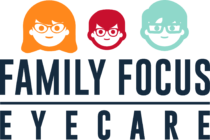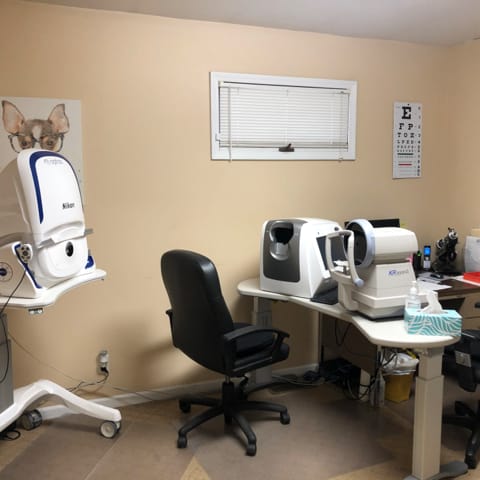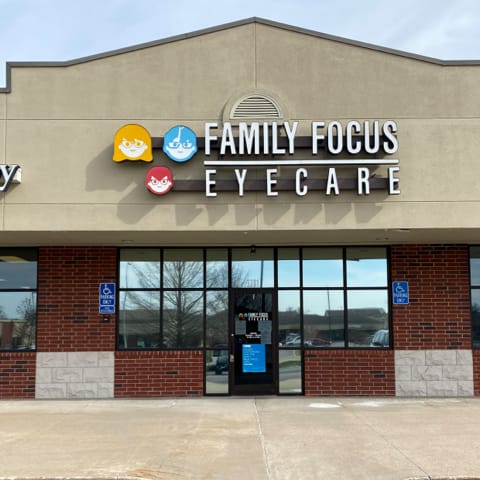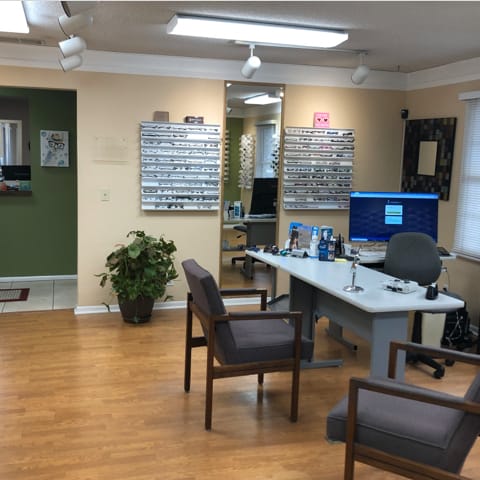Focused on Your Whole Family
Simple vision screenings may test for visual acuity, but your children need a comprehensive children’s eye exam to assess their overall ocular health.
Children can suffer from eye diseases and vision conditions just like adults. Some diseases have no visible characteristics or symptoms, so an eye exam is necessary for timely detection, diagnosis, and treatment.
Please book your child’s appointment with Family Focus Eyecare today and help preserve their sight long into the future.

Conjunctivitis (Pink Eye)
Conjunctivitis is commonly known as pink eye. It causes inflammation in the conjunctiva, the membrane lining the eyelid and covering the eye.
The condition is characterized by an alarming, bright pink or red color in the eye. Kids often report a sandy feeling inside the irritated eye.
Pink eye is uncomfortable and very contagious when caused by a bacterial or viral infection. But, it can also be caused by allergies to pollen, pet hair, and dust or irritation from foreign objects.
Usually, pink eye is not vision-threatening, but as with any infection, there are degrees of severity. If swollen lymph nodes or fever accompany conjunctivitis, or if the condition presents with eye pain, make sure to get medical attention.
Strabismus (Crossed Eyes)
When both eyes look in different directions at the same time, strabismus might be the reason. Strabismus is a muscle condition commonly referred to as crossed eyes.
Strabismus often develops by the age of 3, and, contrary to popular belief, it will not resolve on its own. It’s important to identify and correct strabismus. Proper eye alignment is needed to prevent double vision and develop good depth perception.
The brain relies on the 2 images the eyes send it. When the eyes look in 2 different directions, the brain can’t process the differing images and suppresses vision in the weaker eye to avoid double vision. This can lead to amblyopia (lazy eye).
The condition can be either intermittent or constant, and there are different classifications of strabismus depending on the way the eye is turning:
- Esotropia: Inward turning
- Exotropia: Outward turning
- Hypertropia: Upward turning
- Hypotropia: Downward turning
If you notice your child tilting their head to look at things, struggling with depth perception, or blinking frequently, it might indicate strabismus.
Amblyopia (Lazy Eye)
A large difference in the degree of nearsightedness or farsightedness between the eyes can result in amblyopia. Commonly known as lazy eye, amblyopia usually develops before the age of 6.
When diagnosed early, amblyopia can be treated with great success. Amblyopia won’t resolve on its own and can be much harder to treat later on in life. When uncorrected, the brain can start to ignore the image from the weaker eye, leading to permanent vision loss in that eye.
Premature babies, those with developmental disorders, and babies who were smaller at birth have a higher risk of developing amblyopia.
A Lifetime of Sight Is an Exam Away
Part of making sure kids grow up healthy and happy is making sure they grow up seeing the world clearly. Whether you notice anything abnormal about their sight or not, please book your child’s eye exam today.
Visit One of Our Locations
Columbia
We are in Westbury-1.5 miles further west from our old W. Broadway location, near Toasty Goat and the new Club Carwash
- 725 S. Scott Blvd Suite 101
- Columbia, MO 65203
Our Hours
- Monday: 9:00 AM – 5:00 PM
- Tuesday: 9:00 AM – 5:00 PM
- Wednesday: 9:00 AM – 5:00 PM
- Thursday: 9:00 AM – 5:00 PM
- Friday: 9:00 AM – 5:00 PM
- Saturday: By Appointment
- Sunday: By Appointment
Eldon
Our Eldon location is on Oak Street, two blocks north of the post office and between North and High Street.
- 115 N Oak St
- Eldon, MO 65026
Our Hours
- Monday: 8:30 AM – 5:00 PM
- Tuesday: 8:30 AM – 5:00 PM
- Wednesday: 8:30 AM – 5:00 PM
- Thursday: 8:30 AM – 5:00 PM
- Friday: 8:30 AM – 5:00 PM
- Saturday: By Appointment
- Sunday: By Appointment
Our Brands
View All Brands





Our Testimonials
Dr. Rich is extremely helpful and thoughtful. He cleared up my eye issues within one appointment and even allowed for texts to assess after the appointment. I had been going to a specialist in Columbia for a year and they didn’t even compare to how great Family Focus Eyecare was!
Erin Scrivner
Dr. Barrett is knowledgeable, friendly and practical, I have gone to her for years and trust her. The office staff is great, they are willing to help and make appointments when you need care quickly.
Pamela Didur
The Family Focus Eyecare team is amazing! They really make you feel like home the second you walk through the door. My husband and I both have been very pleased and highly recommend them to anyone in the Columbia area!
Katie Beasley
Twice now, the staff at FFEC have gone above and beyond to help me see clearly. One time I had a contact lens come out while I was driving. It gave me a migrane, and I drove around in desperation trying to find an eye exam since my prescription was expired…. After being turned away in an EMPTY waiting room at the WalMart vision center, and not even being offered a sample pair till an an appointment could be set… I called FFEC and they not only had me come right over, they squeezed me in between two clients, gave me replacement contacts, and informed me my insurance would cover everything because they looked up my plan details for me!! (I didnt even know I had vision coverage). What an exceptional team and business!!!! I was so thankful. This might be the first review I have ever taken the time to write.
Dorian Brownlee
I had a great experience!! Very knowledgeable staff and excited about the new contact lens options! Highly recommend!
Rhonda Bledsoe
Dr. Rich was so great with our 3 year old son! He was patient and sweet. This was during COVID and they were very careful with masks and cleaning. I plan to go back myself and so does my husband.
Amanda Fisher
I had an acute eye problem and FFE was able to get me in within a few days where other places were months out. They diagnosed the problem quickly and I was on my way feeling relieved that I would soon be headache free.
Kasie Sly
The entire team was friendly, efficient and helpful throughout my entire experience. Best customer service experience I’ve had with an eye doctor in Columbia. I would highly recommend them to anyone.
Sarah Carnes
Best of the best! Very quick and courteous. No wasted time and the prices seem very fair for the services rendered. One of my biggest concerns was picking frames and they made it painless. Very pleased, I recommend them without hesitation!
Steve Baumann
Dr. Rich is by far the best eye doctor I have ever met! They went above and beyond to help me find the right pair of frames for me. I get compliments every time I wear them. No matter where I live I will always see Dr Rich for my eye care. I moved to STL and I still make the 2 hour drive to meet with him – totally worth it.
Walter Juarez
Dr. Rich is fantastic! My last eye exam has been years ago and this is my first visit at Family Focus Eyecare. I was immediately impressed with the attentive staff as you walk in, not only were the friendly but also extremely efficient getting me started and keeping me on time. The lobby area is pleasant and has a nice new feel to it. Because this was my first visit I had to go through the typical tests for them to examine my eyes and their technology & equipment are top-notch, it was so easy. Once I met with Dr. Rich he explained everything clearly and especially took the time to ask me many questions about my eyes, habits, difficulties and things I felt needed his attention. After consulting with him thoroughly and running numerous tests I was given a LOWER prescription! He was able to determine my contacts were too strong and what was causing my vision to not be perfect. Everything about my experience was perfect and I highly recommend Dr. Rich and Family Focus Eyecare!
John Sorensen
The staff is so friendly, helpful and very accommodating for kids. My girls are sad that they only get to go once a year.
Joy Lowe

Our Google Reviews

Our Blog
Does Castor Oil Remove Age Spots?
Dry EyeIPLCastor oil can help lighten age spots, but it’s not the most effective. Learn how IPL therapy can effectively remove age spots with Family Focus Eyecare. […]
Does Screen Time Cause Myopia?
Eye careMyopiaA child with large round glasses sitting on a couch and holding a smartphone very close to his face
[…]
Is Hyaluronic Acid Good for Rosacea?
AestheticsDermatologists often recommend HA to treat rosacea because it can provide moisture for parched skin and, when used as part of a customized skincare routine, may improve your complexion. […]
Does Castor Oil Remove Age Spots?

Castor oil can help lighten age spots, but it’s not the most effective. Learn how IPL therapy can effectively remove age spots with Family Focus Eyecare. […]
Does Screen Time Cause Myopia?

A child with large round glasses sitting on a couch and holding a smartphone very close to his face
[…]
Is Hyaluronic Acid Good for Rosacea?

Dermatologists often recommend HA to treat rosacea because it can provide moisture for parched skin and, when used as part of a customized skincare routine, may improve your complexion. […]










